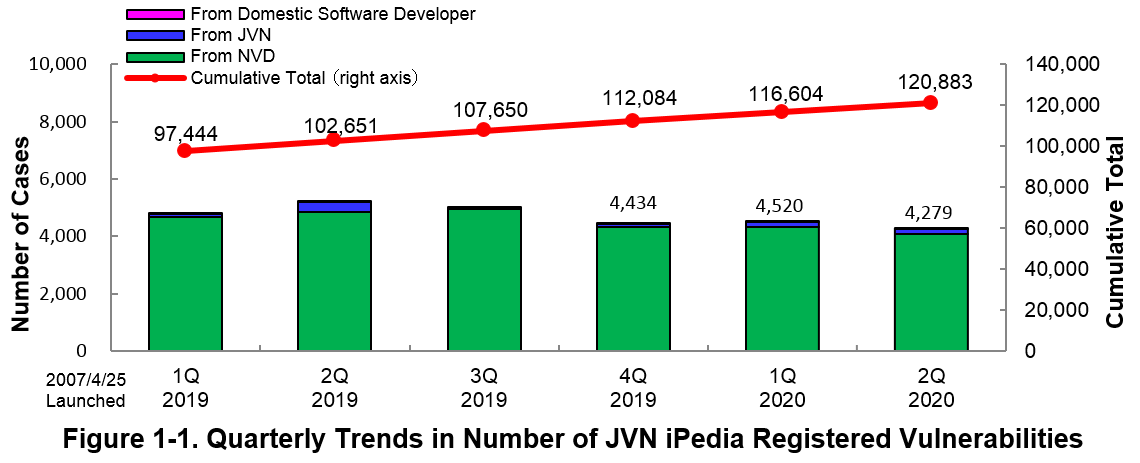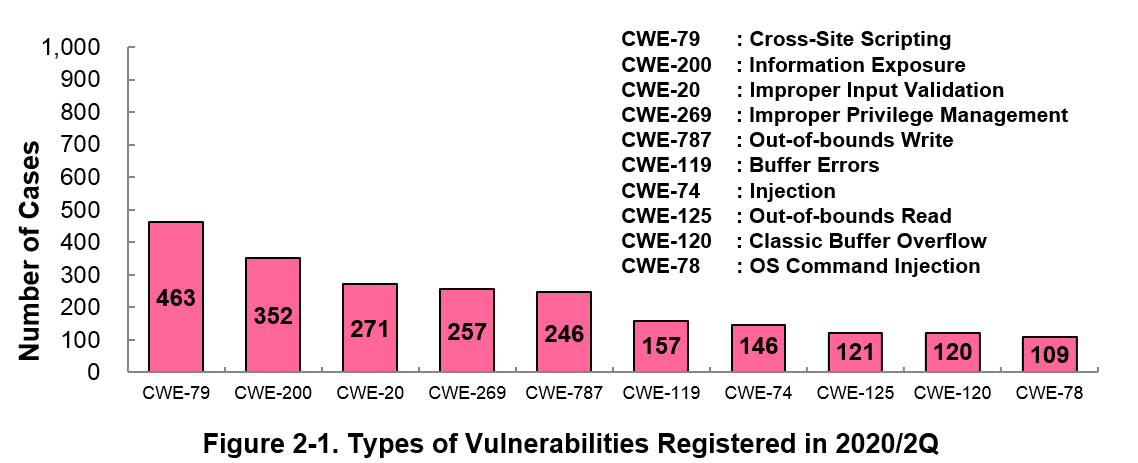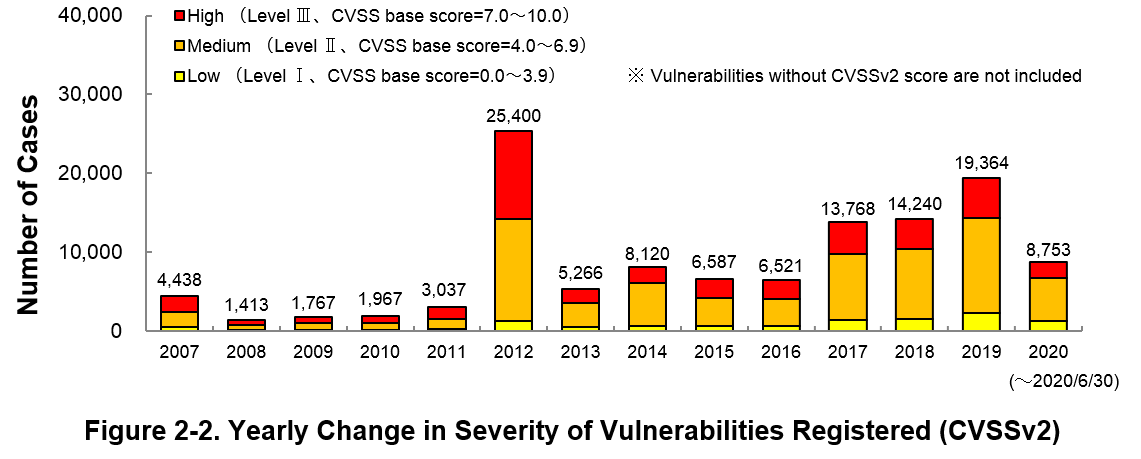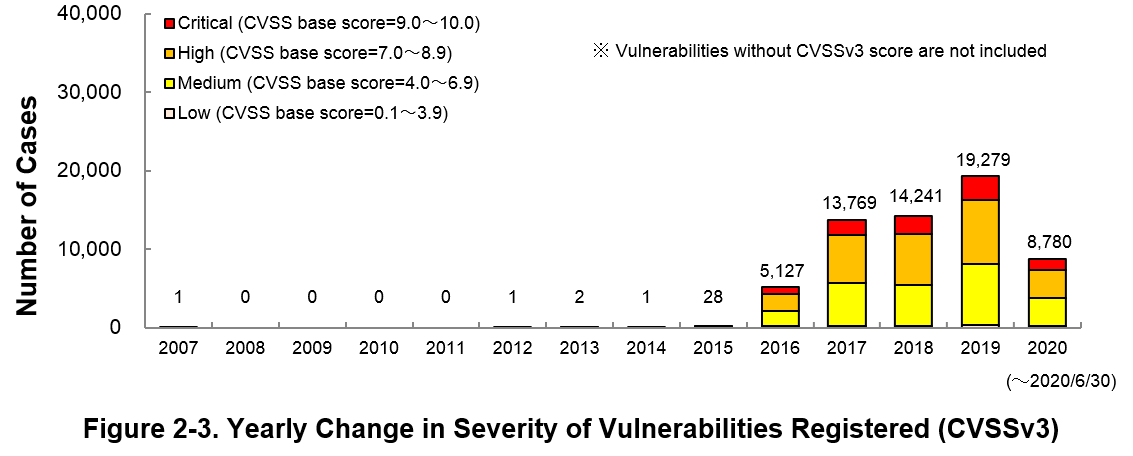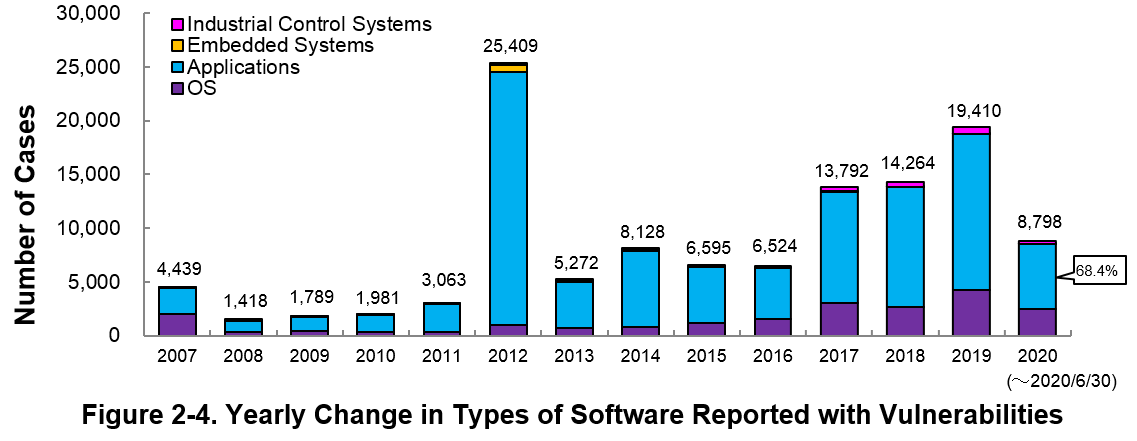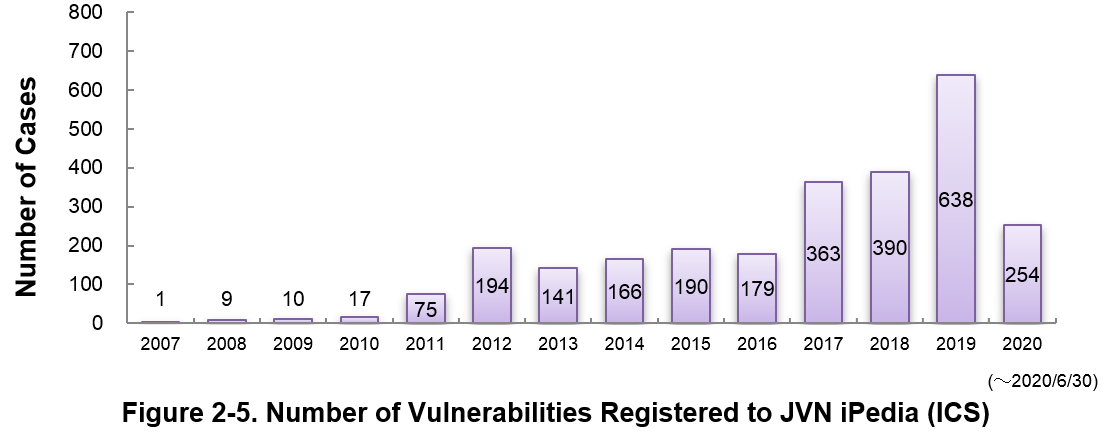Enhancing information security

Vulnerability Countermeasure Information Database JVN iPedia Registration Status [2020 2nd Quarter (Apr. - Jun.)]
Release Date:Aug 19, 2020
IT Security Center
1. 2020 2nd Quarter: Vulnerability Countermeasure Information Database JVN iPedia Registration Status
The vulnerability countermeasure information database JVN iPedia (https://jvndb.jvn.jp/en/) is endeavoring to become a comprehensive vulnerability database where vulnerability information is aggregated for easy access for IT users. JVN iPedia collects and/or translates the vulnerability information published by 1) domestic software developers, 2) JVN (*1), a vulnerability information portal run by JPCERT/CC and IPA, and 3) NVD (*2), a vulnerability database run by NIST (*3). JVN iPedia has been making vulnerability information available to the public since April 25, 2007.
1-1. Vulnerabilities Registered in 2020/2Q
~JVN iPedia now stores 120,883 vulnerabilities~
The summary of the vulnerability information registered to the Japanese version of JVN iPedia during the 2nd quarter of 2020 (April 1 to June 30, 2020) is shown in the table below. As of the end of June 2020, the total number of vulnerabilities stored in JVN iPedia is 120,883 (Table 1-1, Figure 1-1).
As for the JVN iPedia English version, the total number of vulnerabilities stored is 2,159 as shown in the lower half of the Table 1-1.
Table 1-1. Vulnerabilities Registered to JVN iPedia during 2nd Quarter of 2020
|
|
Information Source
|
Registered Cases
|
Cumulative Cases
|
|---|---|---|---|
|
Japanese Version
|
Domestic Software Developers
|
7 cases
|
239 cases
|
|
JVN
|
172 cases
|
9,271 cases
|
|
|
NVD
|
4,100 cases
|
111,373 cases
|
|
|
Total
|
4,279 cases
|
120,883 cases
|
|
|
English Version
|
Domestic Software Developers
|
7 cases
|
237 cases
|
|
JVN
|
20 cases
|
1,922 cases
|
|
|
Total
|
27 cases
|
2,159 cases
|
2. Details on JVN iPedia Registered Data
2-1. Types of Vulnerabilities Reported
Figure 2-1 shows the number of vulnerabilities newly added to JVN iPedia during the 2nd quarter of 2020, sorted by the CWE vulnerability types.
The type of the vulnerabilities reported most in the 2nd quarter is CWE-79 (Cross-Site Scripting) with 463 cases, followed by CWE-200 (Information Exposure) with 352, CWE-20 (Improper Input Validation) with 271, CWE-269 (Improper Privilege Management) with 257, CWE-787 (Out-of-bounds Write) with 246.
CWE-79 (Cross-Site Scripting), the most reported vulnerability type in this quarter, could allow attackers to display false webpages and/or steal information.
Software developers need to make sure to mitigate vulnerability from the planning and design phase of software development. IPA provides tools and guidelines, such as "How to Secure Your Website" (*4), "Secure Programing Guide" (*5) and "AppGoat" (*6), a hands-on venerability learning tool, for website developers and operators to build secure websites.
2-2. Severity of Vulnerabilities Reported
Figure 2-2 shows the yearly change in the CVSSv2 rating scale based severity of vulnerabilities registered to JVN iPedia.
As for the vulnerabilities added to JVN iPedia in 2020, 23.8 percent are “Level III” (7.0 - 10.0), 61.7 percent are “Level ll” (4.0 – 6.9) and 14.5 percent are “Level I” (0.0 – 3.9). This means 85.5 percent of all vulnerabilities registered are Level II or higher, which are potentially critical enough to cause damage like information exposure or data falsification.
Figure 2-3 shows the yearly change in the CVSSv3 rating scale based severity of vulnerabilities registered to JVN iPedia.
As for the vulnerabilities added to JVN iPedia in 2020, 16.0 percent are “Critical” (9.0 – 10.0), 41.5 percent are “High” (7.0 – 8.9), 40.4 percent are “Medium” (4.0 – 6.9) and 2.1 percent are “Low” (0.1 – 3.9).
To avoid threats posed by the known vulnerabilities, both product developers and IT users should pay close attention to vulnerability disclosure and update software they use to a fixed version or apply a security patch as soon as possible when they become available. IT users can check vulnerabilities newly published on JVN iPedia in RSS and XML format (*7) as well.
2-3. Types of Software Reported with Vulnerability
Figure 2-4 shows the yearly change in the type of software reported with vulnerability. Application vulnerabilities have been published most, accounting for 68.4 percent (6,022 out of 8,798) of the 2020 total.
Figure 2-5 shows the yearly change in the number of JVN iPedia-stored vulnerabilities in industrial control systems (ICS) used in critical infrastructure sectors. As of June 2020, the total of 2,627 ICS vulnerabilities have been registered.
2-4. Products Reported with Vulnerability
Table 2-1 lists the top 20 software whose vulnerabilities were most registered to JVN iPedia during the 2nd quarter (April to June) of 2020.
In this quarter, the 1st rank continued to be Microsoft Windows 10 from the previous quarter. From 2nd to 20th, other Windows OS products are also ranked. In addition, many other vulnerability information for OS products are ranked, such as Google’s mobile OS "Android", Apple's OS "iOS", etc.
Besides those in the top 20 list, JVN iPedia stores and offers vulnerability information about a variety of software. IPA hopes software developers and users will make good use of JVN iPedia to efficiently check vulnerability information and take necessary action in a timely manner (*8).
Table 2-1. Top 20 Software Products Vulnerabilities Were Most Registered [Apr. – Jun. 2020]
|
Rank
|
Category
|
Product Name (Vendor)
|
Number of
Vulnerabilities Registered |
|---|---|---|---|
|
1
|
OS
|
Microsoft Windows 10 (Microsoft)
|
333
|
|
2
|
OS
|
Microsoft Windows Server (Microsoft)
|
327
|
|
3
|
OS
|
Android (Google)
|
319
|
|
4
|
OS
|
Microsoft Windows Server 2019 (Microsoft)
|
310
|
|
5
|
OS
|
Microsoft Windows Server 2016 (Microsoft)
|
278
|
|
6
|
Firmware
|
Qualcomm component (Qualcomm)
|
210
|
|
7
|
OS
|
Microsoft Windows Server 2012 (Microsoft)
|
198
|
|
8
|
OS
|
Microsoft Windows 8.1 (Microsoft)
|
196
|
|
9
|
OS
|
Microsoft Windows RT 8.1 (Microsoft)
|
192
|
|
10
|
OS
|
Microsoft Windows Server 2008 (Microsoft)
|
167
|
|
11
|
OS
|
Microsoft Windows 7 (Microsoft)
|
166
|
|
12
|
Development Platform
|
GitLab (GitLab.org)
|
139
|
|
13
|
Browser
|
Google Chrome (Google)
|
133
|
|
14
|
Knowledge Base Software
|
PHPKB (Chadha Software Technologies)
|
119
|
|
15
|
Integrated set of business applications
|
Oracle E-Business Suite (Oracle)
|
97
|
|
16
|
OS
|
iOS (Apple)
|
83
|
|
16
|
OS
|
Debian GNU/Linux (Debian)
|
83
|
|
18
|
OS
|
Apple Mac OS X (Apple)
|
75
|
|
19
|
Browser
|
Mozilla Firefox (Mozilla Foundation)
|
71
|
|
20
|
PDF Viewer/Editor
|
Foxit PhantomPDF (Foxit Software Inc)
|
69
|
3. Most Accessed Vulnerability Countermeasure Information
Table 3-1 lists the top 20 most accessed vulnerability countermeasure information in JVN iPedia during the 2nd quarter of 2020 (April to June).
In this quarter, 18 information except the 15th and 17th rank is vulnerability countermeasure information released on the Vulnerability Countermeasure Information Portal Site JVN. Information released on JVN contains information which publicized based on "Information Security Early Warning Partnership" (*9). That information attracted a lot of interest and appeared on news sites etc. so that the number of access increased.
Rating Scale
Note 1) CVSSv2 Severity Rating Scale
- Level I (Low)
- CVSS Base Score = 0.0~3.9
- Level II (Medium)
- CVSS Base Score = 4.0~6.9
- Level III (High)
- CVSS Base Score = 7.0~10.0
Note 2) CVSSv3 Severity Rating Scale
- Low
- CVSS Base Score =0.1~3.9
- Medium
- CVSS Base Score =4.0~6.9
- High
- CVSS Base Score =7.0~8.9
- Critical
- CVSS Base Score =9.0~10.0
Table 3-1. Top 20 Most Accessed Vulnerability Countermeasure Information in JVN iPedia [Apr. – Jun. 2020]
No.1 Multiple Yamaha network devices vulnerable to denial-of-service (DoS) JVNDB-2020-000021
- CVSSv2 Severity Rating Scale
-
- Level III (High)
- CVSSv2 Base Score
-
7.1
- CVSSv3 Severity Rating Scale
-
- Medium
- CVSSv3 Base Score
-
5.9
- Date Public
-
2020/3/31
- Access Count
-
7,940
No.2 Multiple vulnerabilities in EasyBlocks IPv6 JVNDB-2020-000022
- CVSSv2 Severity Rating Scale
-
- Level II (Medium)
- CVSSv2 Base Score
-
4.0
- CVSSv3 Severity Rating Scale
-
Medium
- CVSSv3 Base Score
-
4.2
- Date Public
-
2020/4/8
- Access Count
-
7,094
No.3 Joomla! plugin "AcyMailing" vulnerable to arbitrary file uploads JVNDB-2020-000024
- CVSSv2 Severity Rating Scale
-
Level II (Medium)
- CVSSv2 Base Score
-
5.0
- CVSSv3 Severity Rating Scale
-
Medium
- CVSSv3 Base Score
-
5.3
- Date Public
-
2020/4/7
- Access Count
-
6,761
No.4 The installer of Microsoft Teams may insecurely load Dynamic Link Libraries JVNDB-2019-000014
- CVSSv2 Severity Rating Scale
-
Level II (Medium)
- CVSSv2 Base Score
-
6.8
- CVSSv3 Severity Rating Scale
-
High
- CVSSv3 Base Score
-
7.8
- Date Public
-
2019/2/28
- Access Count
-
6,541
No.5 Toshiba Electronic Devices & Storage software registers unquoted service paths JVNDB-2020-000025
- CVSSv2 Severity Rating Scale
-
Level II (Medium)
- CVSSv2 Base Score
-
4.6
- CVSSv3 Severity Rating Scale
-
High
- CVSSv3 Base Score
-
8.4
- Date Public
-
2020/4/20
- Access Count
-
6,148
No.6 Denial-of-service (DoS) vulnerability in Mitsubishi Electric MELSOFT transmission port JVNDB-2020-002958
- CVSSv2 Severity Rating Scale
-
- Level II (Medium)
- CVSSv2 Base Score
-
5.0
- CVSSv3 Severity Rating Scale
-
- Medium
- CVSSv3 Base Score
-
5.3
- Date Public
-
2020/3/31
- Access Count
-
5,901
No.7 Multiple SHARP Android devices vulnerable to information disclosure JVNDB-2020-000026
- CVSSv2 Severity Rating Scale
-
- Level I (Low)
- CVSSv2 Base Score
-
2.6
- CVSSv3 Severity Rating Scale
-
Low
- CVSSv3 Base Score
-
3.3
- Date Public
-
2020/4/23
- Access Count
-
5,575
No.8 WL-Enq (WEB Enquete) vulnerable to OS command injection JVNDB-2020-000907
- CVSSv2 Severity Rating Scale
-
Level II (Medium)
- CVSSv2 Base Score
-
6.8
- CVSSv3 Severity Rating Scale
-
High
- CVSSv3 Base Score
-
8.8
- Date Public
-
2020/3/24
- Access Count
-
5,282
No.9 Keijiban Tsumiki vulnerable to OS command injection JVNDB-2020-000908
- CVSSv2 Severity Rating Scale
-
Level III (High)
- CVSSv2 Base Score
-
7.5
- CVSSv3 Severity Rating Scale
-
High
- CVSSv3 Base Score
-
7.3
- Date Public
-
2020/3/24
- Access Count
-
5,163
No.10 WL-Enq (WEB Enquete) vulnerable to cross-site scripting JVNDB-2020-000906
- CVSSv2 Severity Rating Scale
-
Level II (Medium)
- CVSSv2 Base Score
-
4.3
- CVSSv3 Severity Rating Scale
-
Medium
- CVSSv3 Base Score
-
6.1
- Date Public
-
2020/3/24
- Access Count
-
5,070
No.11 Cybozu Garoon contains multiple vulnerabilities JVNDB-2020-000027
- CVSSv2 Severity Rating Scale
-
- Level II (Medium)
- CVSSv2 Base Score
-
5.0
- CVSSv3 Severity Rating Scale
-
- Medium
- CVSSv3 Base Score
-
5.3
- Date Public
-
2020/4/27
- Access Count
-
4,910
No.12 PALLET CONTROL vulnerable to arbitrary code execution JVNDB-2020-000029
- CVSSv2 Severity Rating Scale
-
- Level II (Medium)
- CVSSv2 Base Score
-
6.8
- CVSSv3 Severity Rating Scale
-
High
- CVSSv3 Base Score
-
7.8
- Date Public
-
2020/5/11
- Access Count
-
4,814
No.13 mailform vulnerable to cross-site scripting JVNDB-2020-000900
- CVSSv2 Severity Rating Scale
-
Level II (Medium)
- CVSSv2 Base Score
-
5.0
- CVSSv3 Severity Rating Scale
-
Medium
- CVSSv3 Base Score
-
6.1
- Date Public
-
2020/3/24
- Access Count
-
4,767
No.14 mailform vulnerable to PHP code execution JVNDB-2020-000901
- CVSSv2 Severity Rating Scale
-
Level III (High)
- CVSSv2 Base Score
-
7.5
- CVSSv3 Severity Rating Scale
-
High
- CVSSv3 Base Score
-
7.3
- Date Public
-
2020/3/24
- Access Count
-
4,719
No.15 Morita Shogi 64 for Nintendo 64 devices vulnerable to out-of-bounds Write JVNDB-2020-005570
- CVSSv2 Severity Rating Scale
-
Level III (High)
- CVSSv2 Base Score
-
7.5
- CVSSv3 Severity Rating Scale
-
Critical
- CVSSv3 Base Score
-
9.8
- Date Public
-
2020/6/17
- Access Count
-
4,711
No.16 Sales Force Assistant vulnerable to cross-site scripting JVNDB-2020-000028
- CVSSv2 Severity Rating Scale
-
- Level I (Low)
- CVSSv2 Base Score
-
3.5
- CVSSv3 Severity Rating Scale
-
- Medium
- CVSSv3 Base Score
-
5.4
- Date Public
-
2020/4/28
- Access Count
-
4,636
No.17 Directory Permission Vulnerability in Hitachi Infrastructure Analytics Advisor and Hitachi Ops Center Analyzer JVNDB-2020-003896
- CVSSv2 Base Score
-
-
- CVSSv3 Base Score
-
-
- Date Public
-
2020/4/28
- Access Count
-
4,595
No.18 Panasonic Video Insight VMS vulnerable to SQL injection JVNDB-2019-000056
- CVSSv2 Severity Rating Scale
-
Level II (Medium)
- CVSSv2 Base Score
-
6.5
- CVSSv3 Severity Rating Scale
-
High
- CVSSv3 Base Score
-
8.8
- Date Public
-
2019/9/2
- Access Count
-
4,534
No.19 Multiple vulnerabilities in Movable Type JVNDB-2020-000030
- CVSSv2 Severity Rating Scale
-
Level II (Medium)
- CVSSv2 Base Score
-
6.5
- CVSSv3 Severity Rating Scale
-
Medium
- CVSSv3 Base Score
-
6.3
- Date Public
-
2020/5/13
- Access Count
-
4,435
No.20 Multiple vulnerabilities in Shihonkanri Plus GOOUT JVNDB-2020-000902
- CVSSv2 Severity Rating Scale
-
Level III (High)
- CVSSv2 Base Score
-
7.5
- CVSSv3 Severity Rating Scale
-
High
- CVSSv3 Base Score
-
7.3
- Date Public
-
2020/3/24
- Access Count
-
4,412
Table 3-2 lists the top 5 most accessed vulnerability information among those reported by domestic software developers.
Table 3-2. Top 5 Most Accessed Vulnerabilities Reported by Domestic Software Developers [Apr. - Jun. 2020]
No.1 Directory Permission Vulnerability in Hitachi Infrastructure Analytics Advisor and Hitachi Ops Center Analyzer JVNDB-2020-003896
- CVSSv2 Base Score
-
- -
- CVSSv3 Base Score
-
- -
- Date Public
-
2020/4/28
- Access Count
-
4,595
No.2 Problem with directory permissions in JP1/Operations Analytics JVNDB-2018-010027
- CVSSv2 Severity Rating Scale
-
Level I (Low)
- CVSSv2 Base Score
-
- 3.5
- CVSSv3 Severity Rating Scale
-
Medium
- CVSSv3 Base Score
-
4.9
- Date Public
-
2018/12/4
- Access Count
-
4,252
No.3 Cross-site Scripting Vulnerability in JP1/Performance Management - Manager [Web Console] JVNDB-2020-002278
- CVSSv2 Base Score
-
-
- CVSSv3 Base Score
-
-
- Date Public
-
2020/3/11
- Access Count
-
4,179
No.4 Multiple Vulnerabilities in Hitachi Infrastructure Analytics Advisor and Hitachi Ops Center JVNDB-2020-002219
- CVSSv2 Base Score
-
-
- CVSSv3 Base Score
-
-
- Date Public
-
2020/3/9
- Access Count
-
4,120
No.5 Improper LDAPS Certificate Validation in Hitachi Ops Center Common Services JVNDB-2020-002220
- CVSSv2 Base Score
-
-
- CVSSv3 Base Score
-
-
- Date Public
-
2020/3/9
- Access Count
-
4,104
Footnotes
-
(*1)
-
(*2)
-
(*3)
-
(*4)
-
(*5)
-
(*6)
-
(*7)
-
(*8)
-
(*9)
Past Quarterly Reports
Contact information
IT Security Center,
Information-technology Promotion Agency, Japan (ISEC/IPA)

